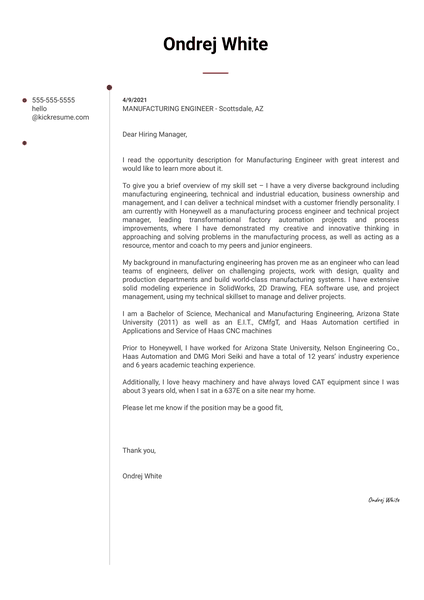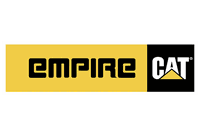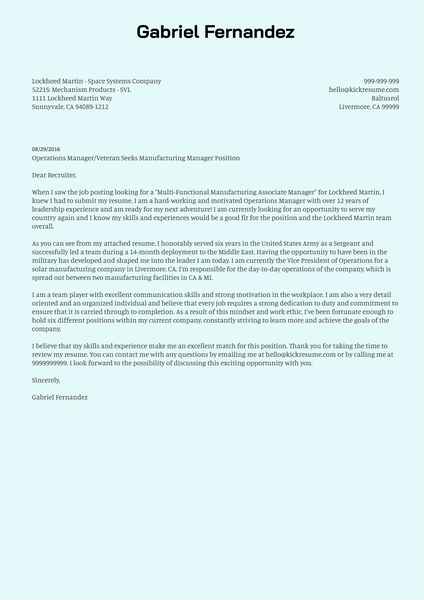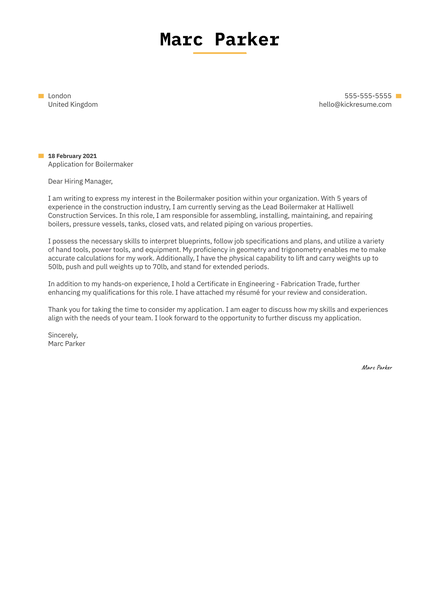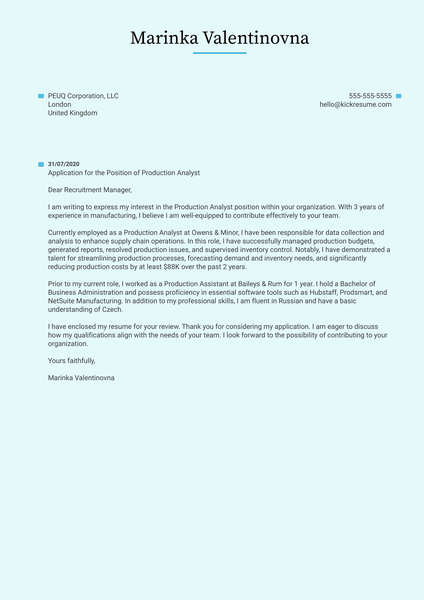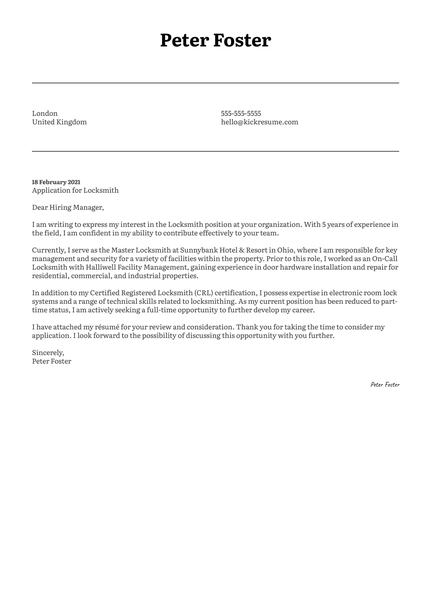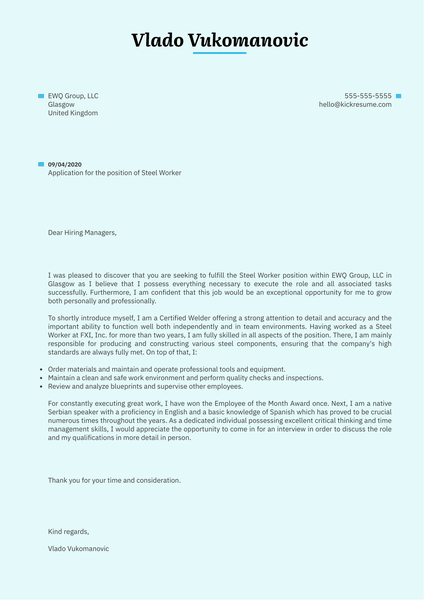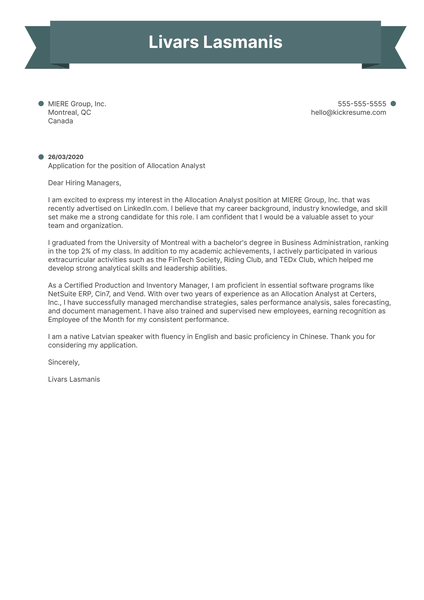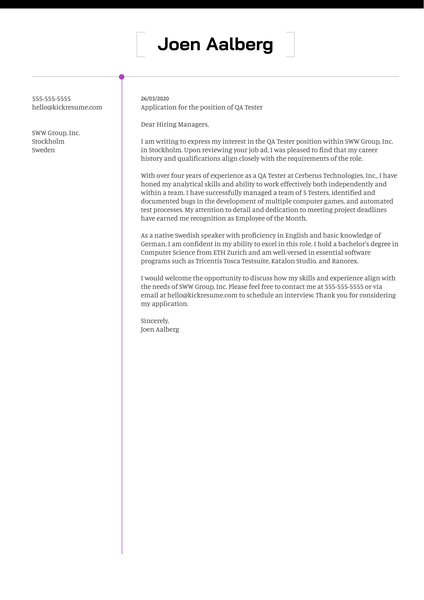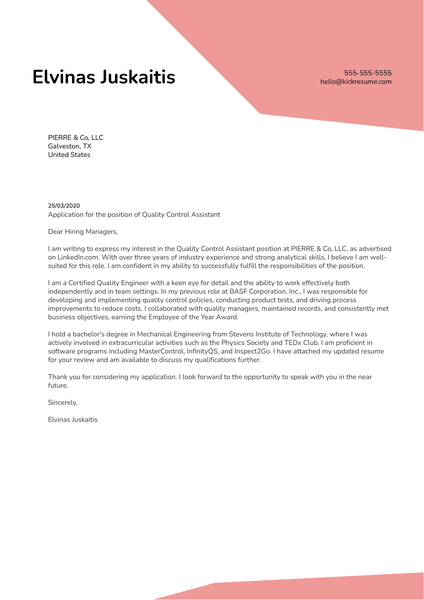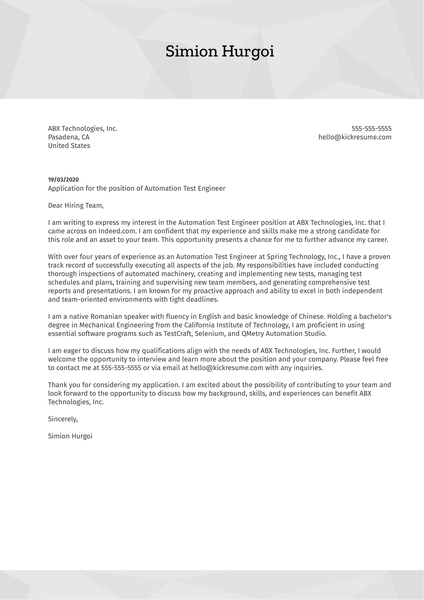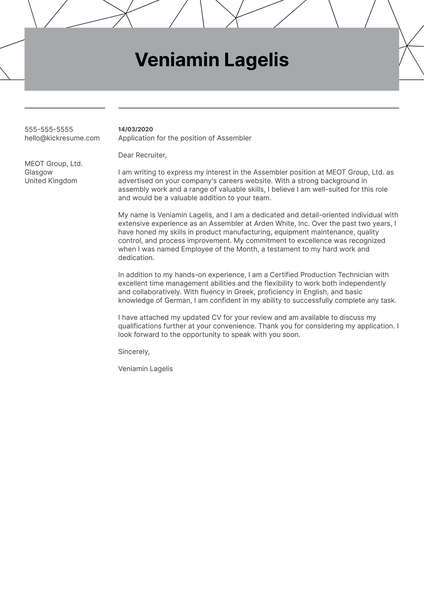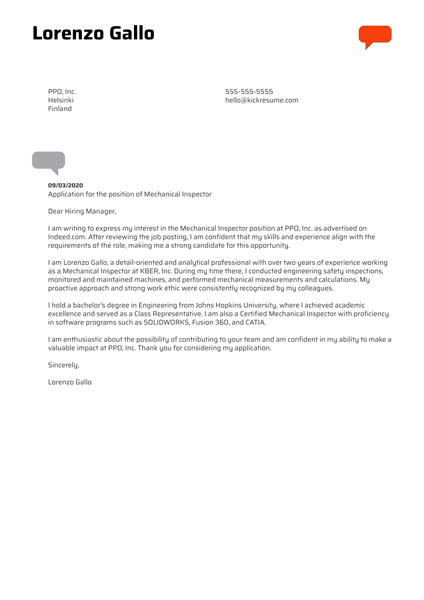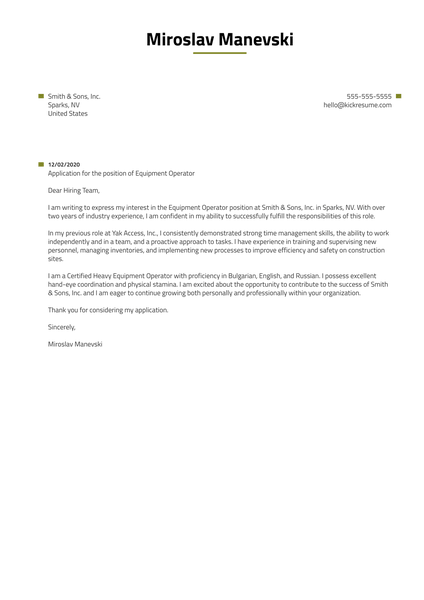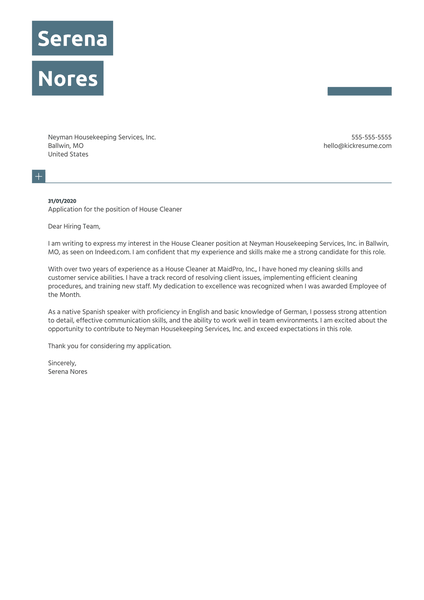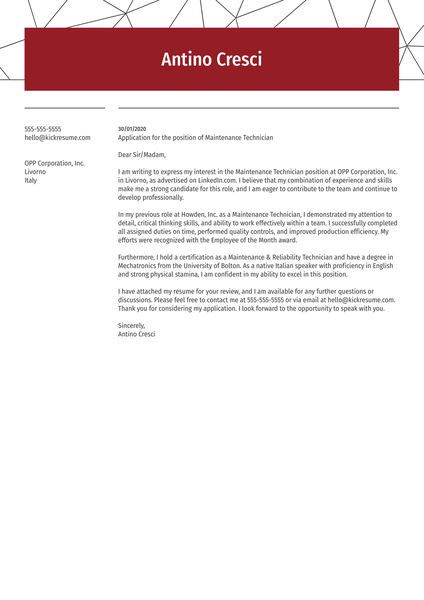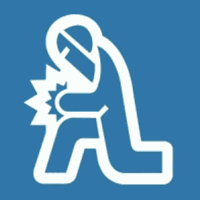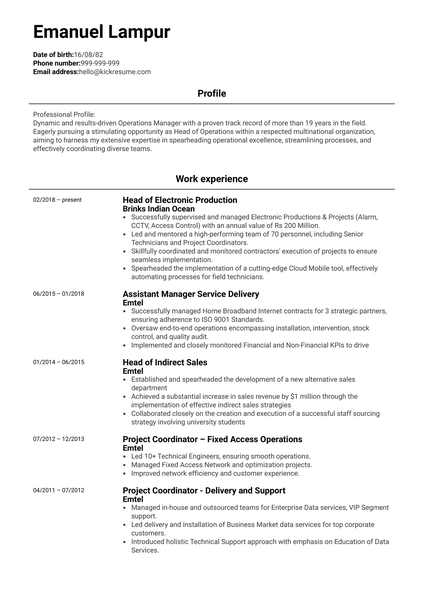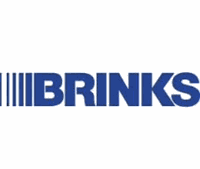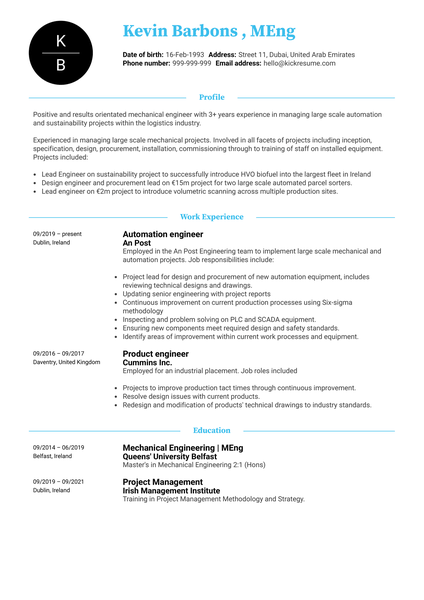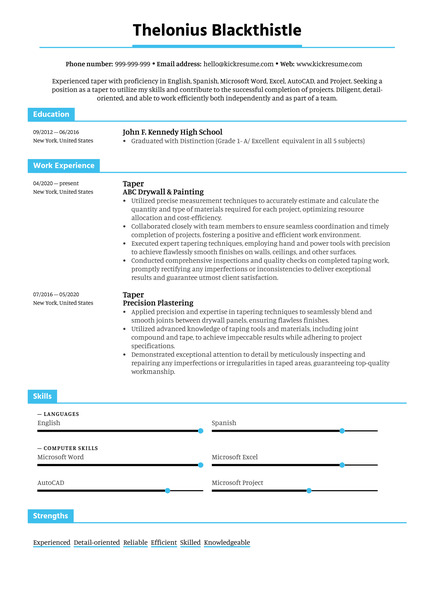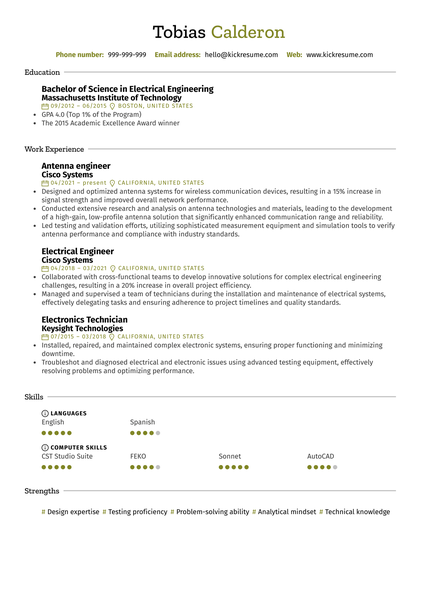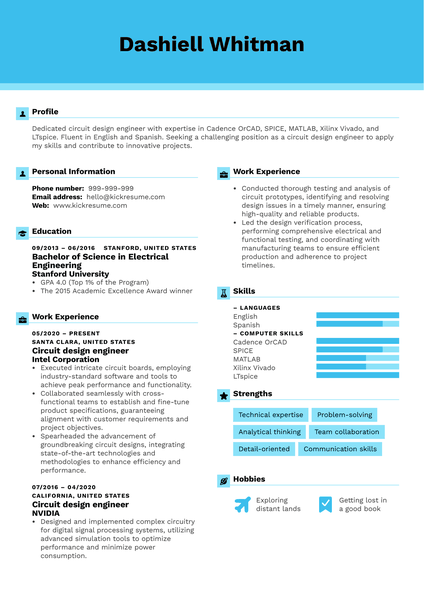Creating a strong manufacturing cover letter is a bit like assembling a product. Each part has a purpose. And when all these parts come together nicely, you have an application that can't be ignored — much like that quality product at the end of the production line.
So, without further ado, let's delve into our handy tips, insights and real-life examples to create an effective manufacturing cover letter. Read on and learn all about:
- Formatting your manufacturing cover letter
- Crafting an effective header
- Creating a compelling headline for your cover letter
- Tailoring the greeting in your manufacturing cover letter
- Writing a compelling introduction for your cover letter
- Showcasing your manufacturing skills and accomplishments
- Building a convincing conclusion to your cover letter
- Avoiding common mistakes in your manufacturing cover letter
- Understanding the average salary and job outlook for manufacturing roles
- Discovering useful resources for jobseekers in the manufacturing industry
1. How to properly format your manufacturing cover letter
A well-formatted cover letter could mean the difference between making a great first impression and your letter being pushed aside. Just as in manufacturing, details matter. So let's focus on how to make your cover letter neat and reader-friendly. Here are some key points:
- Select a professional font: Choose easy-to-read fonts such as Arial, Times New Roman or Calibri, using a size between 10 and 12 to keep it readable.
- Keep it consistent: Whether it's your font, spacing, or bullet points, consistency goes a long way in making your cover letter aesthetic and well-structured.
- Less is more: Ensure all the information fits on a single page. Even though our work in manufacturing can sometimes be complex, a cover letter should be succinct and to the point.
- Use appropriate margins: Maintaining 1-inch margins on all sides will ensure your text is not cramped and stays organized.
- Space it out: Break down your cover letter into 3-4 concise paragraphs. This allows the reader to easily digest the information without being overwhelmed by a wall of text.
- Proofread: Before you send off your cover letter, give it a thorough review. This will help catch any typos or grammatical errors that could potentially disrupt the reading flow. Think of it as a quality assurance stage in the manufacturing process — it's all about attention to detail.
- Save appropriately: When sending your application digitally, save your cover letter as a PDF unless the job posting specifies otherwise. This ensures the formatting stays intact regardless of the device or operating system used by the receiver.
Remember, your cover letter is often the first impression a potential employer has of you. A clean, well-organized format tells them you're meticulous and professional — both in your job applications and potentially, in your job.
2. How create an effective cover letter header
Your manufacturing cover letter, much like any product off the line, starts with crucial specifications — in this instance, the header. It's more than just a formality. It's your first opportunity to say 'hello' to potential employers.
Even more, it's your chance to demonstrate your diligence. You're not tossing your letter into the void — you've done the legwork to address it to the right person or, if necessary, the relevant department.
Your header should include these vital details:
- Your full name
- Your address
- Your contact details including phone number and professional email
- The date you are sending the cover letter
- The name of the recipient
- The recipient's job title
- The company's full address
Let's explore how this should look and why it matters:
Incorrect cover letter header example
John Doe
1234567890
Company XYZ
Why is it weak? While this example does include the applicant's name and information from the company, it's missing critical details. John's address and email are not provided, making it difficult for the company to know where he's applying from and how to contact him if necessary.
Moreover, it doesn’t include the recipient's name and job title, which can make the letter seem impersonal.
Correct cover letter header example
John Doe
123 North Lane
Somewhere, ST 12345
johndoe@example.com
(555) 123-4567
March 1, 2022
To: Mr. Robert Smith
Hiring Manager
XYZ Manufacturing Co.
456 South Street
Elsewhere, ST 67890
Why does it work? This example hits the mark. It's concise and professional, providing all the necessary information for the sender and the recipient. John's full address, email, and contact number are included, ensuring the company can reach out to him with ease. Also, addressing Mr. Smith directly gives the letter a personalized touch.
All in all, the header is your chance to present the most basic, yet important, details about yourself and the recipient. Never underestimate its power to create a great first impression.
3. How to write a compelling cover letter headline
A cover letter headline, much like a news headline, is designed to grab attention. It’s intended to draw the reader in and compel them to read on. In the case of a manufacturing cover letter, your headline needs to succinctly show your competence and enthusiasm for the role.
Here's how to craft a strong cover letter headline:
- Keep it brief: The best headlines are concise but speak volumes about your capabilities.
- Target the job: Your headline should align with the job you're applying for.
- Highlight your selling point: Whether it's your years of experience or a key skill, make it count.
Now, let's look at two contrasting examples:
Weak cover letter headline example
Applying for Manufacturing Role
Why is it weak? This headline says very little about the applicant and doesn't highlight any specific attribute or experience. It merely states an obvious fact — you're applying for a job. And let's face it, it doesn't show what makes you different or better for the job than anyone else.
Strong cover letter headline example
Proven Manufacturing Supervisor with a Decade of Driving Productivity and Efficiency
Why does it work? This headline not only communicates the applicant's relevant position and substantial experience, but it also drives home their impactful work — driving productivity and efficiency. It's layered, specific, and presents a compelling picture of the candidate's track record.
Remember, your headline is the one-liner that could determine whether your application gets the attention it deserves. By making it targeted, brief, yet brimming with your unique selling point, you set the stage for a cover letter worthy of the recruiter's time.
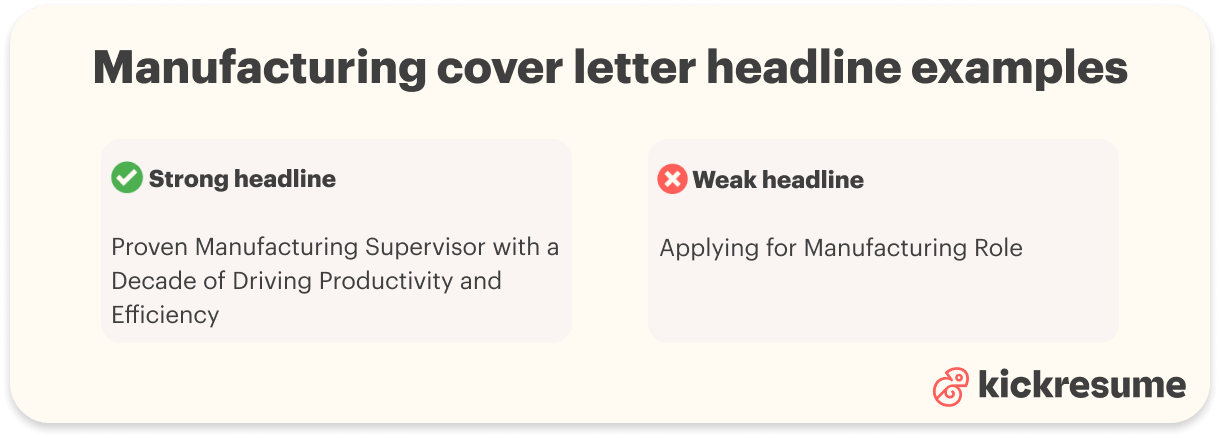
4. How to tailor the greeting on your manufacturing cover letter
It seems a small detail, but the greeting on your cover letter can set the tone for the rest of the document. It’s your first interaction with your potential employer, so getting it right matters.
Why is it important to personalize your greeting, you may ask? Mainly, it shows that you did your homework. Taking a few extra minutes to research the hiring manager’s name demonstrates your interest in the position and respect for the person reading your application.
You typically find this information from the job listing, company website, LinkedIn, or even with a simple phone call to the company's HR department.
Let's look at some alternatives:
Personalized cover letter greeting examples
Dear Mr. Johnson,
Dear Mr. Jake Johnson,
Dear HIring Manager Jake Johnson,
Now, in the case that you can't find the hiring manager's name despite your best efforts, there are still formal ways to address your cover letter:
Acceptable generic greeting examples
Dear Hiring Manager,
To the Manufacturing Team,
Dear Human Resources Team,
Which one you should use depends on how general or specific your knowledge about the recruiting team is. Any of them are viable when the hiring manager's name is not available.
However, as a general rule, it's best to avoid using 'To Whom It May Concern.' While traditionally accepted, this phrase can come across as outdated and impersonal.
So, take that extra step. Do a little digging, and nail that personalized greeting. After all, it's your first chance to show how keen you are about the job.
5. How to write a compelling opening for your cover letter
The opening paragraph, or introduction, of your cover letter is your first big chance to hook the reader. In this section, you should provide a brief overview of your professional and academic history, a clear statement of your interest in the position, and if applicable, mention any mutual connections.
To better illustrate this, let's dive into a few examples and assess their effectiveness:
Weak cover letter introduction example
I am writing this cover letter as I am applying for your job opening. I have a degree in Mechanical Engineering and I have worked in manufacturing before.
What’s the problem here? This opening is too generic. While it mentions a relevant degree and some experience in the field, it doesn't convey anything unique about the candidate or their experiences. It lacks specificity and action-oriented language.
Strong cover letter opening example for an experienced professional
As a seasoned Production Supervisor with a decade-long track record of ensuring safety standards and production efficiency in high-volume manufacturing environments, I was thrilled to see the opening at XYZ Manufacturing Corp. I have long admired XYZ's commitment to innovative manufacturing practices, which resonates closely with my professional ethos.
Why is it a winner? This introduction immediately showcases the candidate's relevant experience and ties it to the role, demonstrating a strong alignment with the job requirements. It manages to be concise, detailed, and reflect the applicant’s enthusiasm for what the company does. This sets the candidate apart early on as invested and well-researched.
Strong cover letter opening example for a fresh graduate
Fresh out of Northwestern University with a degree in Industrial Engineering and a steadfast passion for efficient manufacturing systems, I was excited to discover the graduate opening at XYZ Manufacturing Corp. My hands-on experience during my academic internships ignited my interest in manufacturing efficiency — a key focus at XYZ.
Why does this tick the right boxes? This candidate doesn't have years of professional experience, but they maximize what they do have. Their degree and internships are directly linked to the company and the role. Their enthusiasm for the company's specific focus suggests they’re dedicated and genuinely interested, not just scattering generic resumes.
In a nutshell, use the introduction to dive right into the heart of the matter — who you are, what you bring to the table, and how aligned you are to the job role. Whether you're a seasoned professional or a fresh graduate, showcasing your relevant attributes and enthusiasm for the company can help your application land in the 'yes' pile.
6. How to highlight your top skills and accomplishments
The body of your cover letter is your prime real estate. It’s the portion dedicated to flaunting your skills and experiences, painting a vivid picture of how beneficial you'd be to the company. It’s where your abilities and achievements shine.
But don't just mention your most significant achievements and skills. Take it a step further by providing specific instances where you used these skills effectively.
If you've got experience in the manufacturing sector, your professional skills and achievements should fill this section.
Here are some skills that you might want to highlight
- Proficiency in operating manufacturing machinery
- Quality control and assurance
- Production planning
- Knowledge of manufacturing best practices
- Troubleshooting skills
- Health and safety regulations
- Team leadership and management
- Lean manufacturing principles
- Technical skills relevant to the specific manufacturing sector
Let's check out some examples:
Cover letter body paragraph examples for an experienced professional
In my previous role as a Production Supervisor at ABC Manufacturing, I brought my expertise in quality control to significantly reduce product defects by 30% in the first quarter. This achievement was a result of implementing a rigorous QC system that I had developed, demonstrating my strong grasp of manufacturing best practices.
Furthermore, my knack for lean manufacturing principles facilitated a reduction in waste by 40% over a year, leading to cost savings. Managing, training, and overseeing a team of 20+ workers, I fostered a high-performance work environment that prioritized safety and efficiency.
Why does it work? This example works well because it highlights relevant and impressive achievements using measurable results. It also shows how the applicant's skills have been effectively used in their past work.
For those of you fresh on the job market or transitioning into manufacturing from a different field, focus instead on relevant transferable skills and coursework or internships if applicable.
Don't write-off experiences just because they aren't directly in a manufacturing environment. Maybe you've worked in a team project which required organized coordination, or perhaps a part-time job taught you about handling high-pressure situations. Highlight what makes these experiences valuable
Cover letter body paragraph examples for a fresh graduate
During my academic tenure at XYZ University, I took part in multiple group projects that honed my teamwork and project management skills. One such project involved designing a prototype for a recycling machine. Along with my team, I managed the project and contributed significantly to the engineering design processes. Thanks to our collective efforts, the project was chosen as the Department's project of the year.
Also, as an intern for DEF Company, a fast-paced startup, I thrived in a pressure-intensive environment. These experiences have equipped me with the ability to handle high-stress scenarios, a skill I am confident would be beneficial in the fast-paced world of manufacturing.
Why does it work? This example works as it brings out relevant skills (teamwork, project management, ability to handle pressure) and ties them back to potential success in the manufacturing sector. It underscores the candidate's potential, even though they lack direct professional experience in manufacturing.
Remember, the body of the cover letter is your golden opportunity to pitch yourself, so make the most of it. Highlight your skills, demonstrate them with solid examples, and let your potential employer see why you are right for the job.
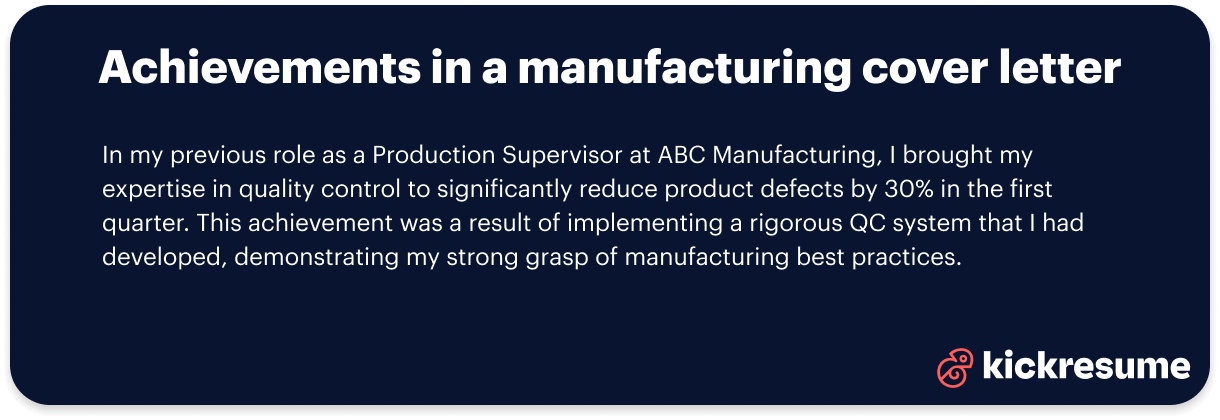
7. How to persuasively end your manufacturing cover letter
The concluding paragraph of your cover letter acts as your closing argument. It's your final chance to leave a lasting impression and signal to the hiring manager that you're eager to move forward in the process.
This paragraph should:
- Reiterate your interest in the role
- Include your contact information and availability for follow-ups
- Accommodate a courteous sign-off
Firstly, why is it important? The conclusion seals the deal. It brings your cover letter full circle by reinforcing your interest in the job, reminding them why you’re a strong match, and indicating a plan for a follow-up.
Let's check out some examples:
Incorrect cover letter conclusion example
I look forward to possibly getting this role. Feel free to reach out at your convenience.
Regards,
[Your Name]
Why doesn’t it work? This closing is lackluster and noncommittal. It lacks a strong demonstration of interest or any proactive initiative for further communication, and it doesn't provide clear contact details for the reader.
Correct cover letter conclusion example
I am excited about the opportunity to bring my unique blend of skills and experience to a forward-thinking company like XYZ Manufacturing. I am eager to demonstrate how my abilities can align with your goals in a personal meeting. You may reach me at (123) 456-7890 or via email at name@email.com. If I don’t hear back, I will follow up in a week.
Thank you for considering my application.
Sincerely,
[Your Name]
Why does it work? This closing is assertive, professional, and proactive — it effectively summarizes the applicant's capabilities, shows eagerness for a face-to-face meeting, provides clear contact details and sets a clear plan for follow-up. It ends on a polite and optimistic note.
Never underestimate the power of a strong closing to your cover letter. It can cap off your introduction by leaving a positive image in the reviewer's mind.
8. How to avoid common mistakes in a manufacturing cover letter
Just like a single malfunctioning component can disrupt an entire assembly line, a small mistake on your cover letter can undermine your entire application. We all stumble; the trick lies in dusting ourselves off and learning not to trip over the same stone again.
Here, we'll look at some common mistakes people tend to make and how to avoid them:
- Not personalizing your cover letter: Avoid generic greetings like ‘To whom it may concern’. Always aim to address your cover letter to a specific person. If you can't find a name, try something like 'Dear [Job Title] Hiring Team.'
- Focusing solely on yourself: While your cover letter should highlight your fit for the position, don't use it merely as a platform to tout your accomplishments. Also, make sure to illustrate how you could deliver value to the prospective employer.
- Writing a cover letter that's too long: While it's crucial to highlight key points, there's no need to detail everything. Recruiters usually skim through applications due to time constraints, so keep it concise and stick to one page.
- Neglecting to proofread: Typos and grammatical errors can come across as lack of attention to detail. Always proofread your cover letter or have someone else look it over.
- Rehashing your resume: Your cover letter is not a repeat of your resume. It offers a chance to explain your value proposition, tell your professional story and pique the hiring manager's interest to read your resume.
In the end, dodging these common cover letter pitfalls is all about being meticulous, relevant, and clearly passionate about the role. After all, your next career move could be just a click away!
9. Average salary and job outlook for manufacturing professionals
According to the most recent data from the Bureau of Labor Statistics (BLS), manufacturing professionals have a promising avenue to explore in terms of job availability and compensation.
Assemblers and fabricators are projected to be in demand with an impressive average of 188,600 job openings per year over the decade. This underlines the steady demand for skilled professionals in the manufacturing sector.
A closer look at the wage structure reveals that the higher paying occupations of industrial production managers and industrial engineers earn significantly more than the median for all occupations. Their average salaries are coming in at $107,560 and $96,350 respectively, as compared to the average of $46,310 for all jobs in 2022.
In summary, the manufacturing sector offers strong prospects for those equipped with the appropriate qualifications and experience. Whether you're considering a shift in career or just starting on your professional journey, manufacturing offers potential for growth and competitive compensation.
10. Valuable resources for manufacturing job seekers
Embarking on a job search can be quite an adventure, filled with its fair share of twists and turns. To streamline this process, we've curated some resources that can be valuable tools in your quest for that perfect job in the manufacturing sector.
Let's break this down:
- Job search platforms: Websites like Indeed, Glassdoor, Monster, and LinkedIn are teeming with job postings from the manufacturing sector. Set up job alerts on these platforms tailored to your desired role and location for real-time updates.
- Industry-specific websites: Channels like the National Association of Manufacturers (NAM) are a great place to start. Not only do they post job openings, but they also provide industry news and insights.
- Networking: Never underestimate the power of a strong professional network. Attend industry events, join online forums, and connect with industry professionals on platforms like LinkedIn.
- Local workforce development boards: These organizations often have partnerships with local employers and may provide job placement services.
- Manufacturing trade associations: Groups such as the Association for Manufacturing Technology, and The Alliance for American Manufacturing regularly post job openings and industry updates.
- Manufacturing news sites: Pages like IndustryWeek not only help you stay current with industry news but also often post job listings.
- Local community colleges or universities: Many higher education institutions offer job placement services to their students and alumni, and often have job boards open to the public.
- Manufacturing job fairs: Keep an eye out for these events in your local community or major cities nearby. They offer a great opportunity to meet potential employers face-to-face.
- Company career pages: Many manufacturing companies, regardless of size, feature a 'Careers' page on their websites. Regularly checking these pages can give you a jump on fresh postings and allow direct application submissions. It's an ideal way for students, interns, or experienced professionals to land their next manufacturing industry role.
Remember, every resource you engage adds a layer of depth to your job search strategy. Keep your tools tillered, eyes on the prize, and maintain the grind — the more avenues you explore, the better your chances of landing that perfect manufacturing role.
Manufacturing Cover Letter FAQ
Can I use the same cover letter for different manufacturing jobs I am applying for?
While it’s tempting to save time by using one cover letter for all your applications, it’s not recommended. Different jobs have unique requirements, even within the same industry. Tailor your cover letter to reflect the specific needs of each individual job.
Should I detail all my past job experiences in my manufacturing cover letter?
No, keep your cover letter focused and concise. Highlight only those experiences which are most relevant to the position you're applying for. Your resume can contain a complete employment history.
How should I address gaps in my employment on a manufacturing cover letter?
If there are significant employment gaps in your history, it’s best to briefly acknowledge them in your cover letter. Be honest but positive, focusing on what you gained during this period, such as volunteer work or relevant courses taken.
What if I have a contact within the company? Can I mention that in my cover letter?
Yes, referring to a mutual acquaintance when writing a cover letter can be a significant advantage. It lends credibility to your application and can help grab the recruiter’s attention.
Should I include references in my manufacturing cover letter?
Generally, it is not necessary to include references in your cover letter. References are typically requested during the interview stage or included separately in your application. Using valuable cover letter space for references may cause you to skip mentioning vital skills and experiences.

